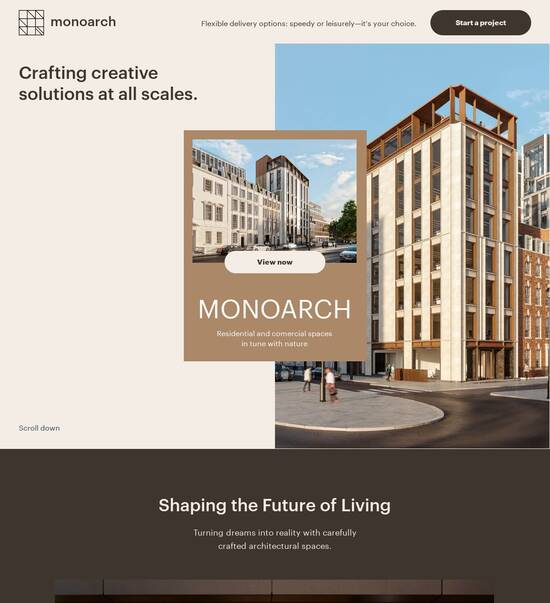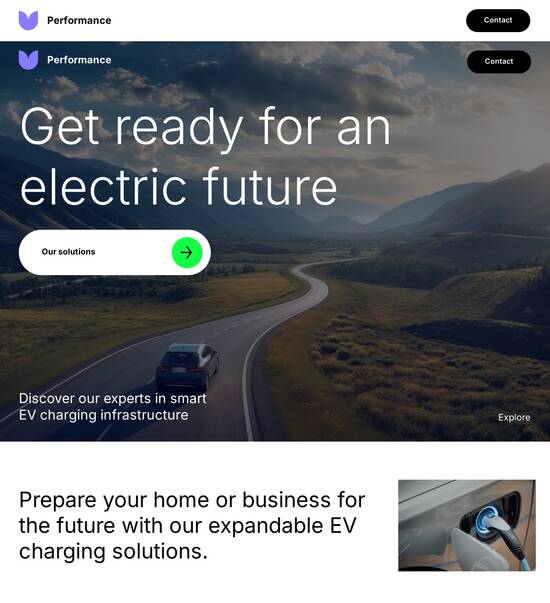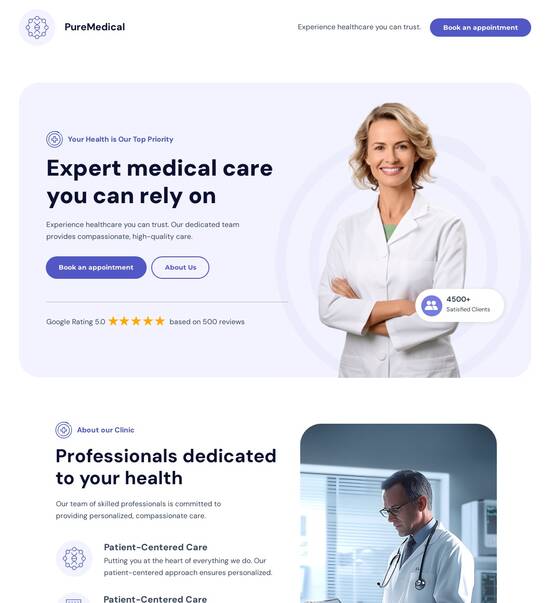
User journey page template optimized for Fitness tracker
Explore Similar TemplatesAbout template
Design using a responsive user journey page template that delivers a flawless experience on Fitness tracker. Try Instapage today!
Recommended templates

Easy to build without coding
With the intuitive drag-and-drop builder, anyone on your team can create high-converting pages without any knowledge of code or design. Make enhancements to your landing page with custom widgets using Javascript, HTML/CSS, or third-party scripts.

Multiple layouts for any industry and goal
Select from 500+ landing page layouts built to boost conversions across industry-specific scenarios. Customize them by adjusting fonts, adding images, and generating on-brand content with the AI assistant. Quickly scale with Instablocks® and Global Blocks that you can save, reuse, and update globally.

Loads fast and looks polished on any device
Every template is responsive, which means they present professionally on any device and load blazingly fast with our Thor Render Engine. You can also power them up with Google AMP technology to deliver an unparalleled mobile experience and drive higher conversions.

Robust analytics & experimentation
Get real-time updates and reporting across all your devices, showing the number of visitors, conversions, cost-per-visitor, and cost-per-lead. Launch AI-powered experiments, run A/B tests, and use heatmaps to analyze user behavior, then optimize your landing page to maximize conversions.







Easy to build without coding
With the intuitive drag-and-drop builder, anyone on your team can create high-converting pages without any knowledge of code or design. Make enhancements to your landing page with custom widgets using Javascript, HTML/CSS, or third-party scripts.
Multiple layouts for any industry and goal
Select from 500+ landing page layouts built to boost conversions across industry-specific scenarios. Customize them by adjusting fonts, adding images, and generating on-brand content with the AI assistant. Quickly scale with Instablocks® and Global Blocks that you can save, reuse, and update globally.
Loads fast and looks polished on any device
Every template is responsive, which means they present professionally on any device and load blazingly fast with our Thor Render Engine.
Robust analytics & experimentation
Get real-time updates and reporting across all your devices, showing the number of visitors, conversions, cost-per-visitor, and cost-per-lead. Launch AI-powered experiments, run A/B tests, and use heatmaps to analyze user behavior, then optimize your landing page to maximize conversions.
All the features you need to build lead-generating landing pages
Explore more featuresLearn how to build top-performing landing pages for any goal
FAQs
Leading the way in building high-performing landing pages





Craft the perfect landing page with Instapage for maximum ROI
Creating high-converting landing pages has never been easier with Instapage’s powerful tools and templates. By utilizing an intuitive page builder and optimization features, marketers can accelerate their campaigns and enhance their return on investment (ROI). Instapage allows you to design tailored experiences that resonate with your audience, leading to better engagement and increased conversions.
Understanding your audience is the first step
Before you start designing your landing page, it's crucial to identify your target audience. Understanding their needs, preferences, and pain points will inform your design choices and messaging. For sectors like education, financial services, or government, a deep dive into user personas can reveal insights that shape a more effective landing page.
- Identify key demographics: Understand age, gender, location, and income levels of your target audience.
- Research user behavior: Use tools like heatmaps to see how users interact with your existing pages.
- Analyze competitors: Look at industry leaders in your vertical to discover effective messaging and designs.
Choose the right template and lead generation elements
Once you understand your audience, it’s time to select a template that fits your objectives. Instapage offers over 100 ready-to-use templates, which can be customized to align with your branding. Additionally, incorporating lead generation elements like forms and call-to-action buttons can drastically improve your page's effectiveness.
- Select a conversion-focused template: Use Instapage's template library to find layouts tailored for your specific campaign goals.
- Utilize lead generation tools: Leverage opt-in forms, social proof elements, and compelling CTAs to capture your audience’s information.
- Personalization: Implement dynamic text replacement to cater your messaging to individual visitors based on their previous interactions.
Optimize your landing page for success
Optimization is key to maximizing your landing page's performance. With Instapage, you can utilize A/B testing and real-time analytics to refine your pages. By measuring user interaction and engagement, you can identify what works and what doesn’t, allowing for iterative improvements.
- A/B testing: Experiment with different headlines, images, and CTA placements to see what resonates most with your audience.
- Heatmaps: Analyze user behavior to discover which sections of your page attract the most engagement.
- Analytics integration: Use your analytics dashboard to assess performance metrics and user pathways.
By following these steps, you can create a landing page that not only draws visitors in but also converts them into leads or customers, ultimately maximizing your marketing ROI.
Ready to take your landing pages to the next level? Start using Instapage to build high-performing digital experiences that resonate with your audience and drive results.
Join the many marketers who are empowered by Instapage's advanced tools and start transforming your landing page strategy today!
People also ask about User journey page template optimized for Fitness tracker
Unraveling the User Journey Page Template for Fitness Trackers
Understanding the user journey in fitness tracking
The user journey in fitness tracking refers to the entire experience a user has while interacting with a fitness tracker. This encompasses initial awareness, the decision-making process, engagement with the device or app, tracking progress, and ultimately, achieving fitness goals. Each stage presents unique opportunities and challenges, emphasizing the need for a streamlined and user-friendly interface. By understanding this journey, designers can create templates that cater specifically to the needs of fitness enthusiasts.
The importance of personalization cannot be overstated in fitness tracking. Tailoring experiences based on user preferences, motivations, and health goals increases engagement and retention. Users benefit greatly from features that adapt to their individual fitness levels and goals, making them feel valued and understood. Mapping the user journey thus becomes essential, revealing how users interact with fitness trackers and identifying areas for enhancement to enrich their overall experience.
Enhanced Engagement: Personalized content keeps users motivated.
Increased Retention: Users are more likely to stick with the app that caters to their unique journey.
Greater Satisfaction: Targeted features lead to improved user satisfaction and outcomes.
Core components of a fitness tracker user journey page template
A fitness tracker user journey page template should have a clear, structured layout that guides users through their fitness experience. Key sections typically include awareness, goal setting, progress tracking, workout customization, and results analysis. Customization options should be readily available, allowing brands to differentiate their interface while maintaining usability. This personalization is vital to resonance with their target audience, ensuring that the template caters to diverse user needs.
Visual elements also play a critical role in creating an inviting interface. A well-chosen color scheme can evoke the right emotions, encouraging users to engage. Imagery should reflect diversity and inclusivity, appealing to varied demographics. Infographics serve as powerful tools in the interpretation of complex data, such as workout statistics or nutrition information. By integrating infographics, users can quickly grasp their achievements and areas needing improvement, enhancing their overall experience.
Key Sections: Include awareness, goal-setting, workout routine and tracking.
Customization Options: Ensure flexibility for distinct branding.
Visual Elements: Use color, imagery, and infographics to highlight data.
Health goals: A central focus in fitness tracking
Health goals serve as the core motivation for many users engaging with fitness trackers. These goals can be classified into short-term and long-term aims. Short-term goals might include daily step counts or weekly exercise targets, while long-term objectives often relate to weight loss, muscle gain, or maintaining a certain fitness level. By clearly defining these goals within the template, users can stay focused and motivated throughout their fitness journeys.
Integrating goal-setting features into the journey page can significantly enhance user experiences. Allowing users to define their goals ensures personalized tracking experiences, fostering a sense of ownership. Moreover, the template should highlight achievable milestones. Recognizing small successes can motivate users to continue their fitness journey, ultimately leading to larger health achievements. Celebrating these milestones creates a positive reinforcement loop that is critical in maintaining long-term engagement.
Defining Health Goals: Short-term vs. Long-term.
User-Defined Goals: Encouraging personalization.
Achievable Milestones: Fostering a sense of accomplishment.
Journey tracking: Elevating the fitness experience
A comprehensive fitness journey tracker is integral to enhancing user experience with fitness trackers. Essential features should include effective progress tracking that allows users to log workouts and receive real-time feedback. Progress tracking helps users visualize their achievements and identify areas needing improvement. Visual elements such as graphs and charts can be pivotal in displaying progress over time, while timeline functions give users a narrative of their fitness journey, enhancing engagement.
The basics of progress tracking encompass collecting data on workouts, such as frequency, intensity, and duration. This data, when effectively visualized, allows users to comprehend their workout habits better. Furthermore, integrating a nutrition tracking feature, such as a food diary, complements the fitness tracker experience. Users can monitor their calorie intake alongside workout data, offering a more holistic view of their health journey and encouraging healthier habits.
Collecting Data: Workouts frequency, intensity, and duration.
Visualizing Progress: Use of graphs, charts, and timelines.
Tracking Nutrition: Integration of food diary features.
Engaging workouts and routines: Maximizing user investment
Creating a customizable workouts section within the user journey page template is crucial for engaging users. Pre-loaded routines provide inspiration, but allowing users to create their schedules ensures that the workouts fit within their lifestyles. The template should facilitate dynamic routines, encouraging users to switch things up regularly to prevent boredom and boost motivation. Variety in workout routines not only aids in physical performance but also keeps the engagement high.
In terms of tracking workouts, simplifying entry with quick-access features is essential for maintaining user interest. When users can log their progress swiftly, they are less likely to abandon the experience. Notifications and reminders can also be employed strategically to nudge users towards their goals, fostering continued participation. Together, these features can establish a more satisfied and involved user base that sees the value in their fitness tracker.
Customizable Workouts: Pre-loaded vs. user-created routines.
Tracking Process: Quick-access features for simple data entry.
User Engagement: Utilizing notifications and reminders.
Results and feedback loop: The key to continued success
Analyzing results effectively is crucial for users to understand their fitness progress. The user journey page should present key metrics that matter, such as weight fluctuations, improvements in endurance, and strength gains. Automated reports can streamline this process, providing users with regular insights based on their collected data. This automation makes it easier for users to stay informed without having to manually analyze their performance.
Creating a feedback loop enhances user engagement and satisfaction. Implementing user surveys and feedback forms allows for gathering valuable insights on user experiences. By regularly updating the template based on this feedback, brands can adapt to evolving user needs. Iterative improvements make users feel heard, promoting loyalty and long-term interest in the fitness tracking experience. Engaged users are more likely to share their positive experiences, further expanding the template's reach.
Analyzing Results: Key metrics such as weight and strength gains.
Automated Reports: Regular delivery of insights.
Creating a Feedback Loop: Surveys and adaptive features.
Celebrate milestones: Fostering community and motivation
Celebrating milestones can motivate users to stay committed to their fitness journeys. Users appreciate recognition for their achievements, and milestone recognition features can significantly enhance user engagement. Gamification techniques such as badges, achievements, and leaderboards create an atmosphere of friendly competition. This approach encourages users to strive for their goals while feeling part of a larger community.
Integrating social media functionalities allows users to share their successes, which fosters community and accountability. Encouraging users to share their progress creates a sense of belonging while inspiring others. Additionally, forums and discussion boards can facilitate interaction among users, allowing them to share tips and support each other. Introducing accountability partners enhances this community aspect, as participants can motivate each other towards shared fitness goals.
Milestone Recognition: Use of gamification techniques.
Sharing Success: Integrating social media functionality.
Community Engagement: Forums and accountability partners.
Optimizing navigation and usability
User-centric design principles are crucial for optimizing navigation and usability within a fitness tracker template. Clear navigation routes allow users to locate features with ease, enhancing their overall experience. Creating intuitive pathways for users to enter their data can significantly reduce user frustration and increase engagement. Streamlined interfaces ensure that basic functionalities are easily accessible without cluttering the screen with unnecessary information.
Mobile optimization should not be overlooked, as many users will engage with fitness trackers via their smartphones. Features such as easy-to-navigate menus and quick data entry functions should be available on mobile devices. Ensuring that the template maintains responsiveness across different screen sizes is vital. Cross-platform synchronization is equally essential, as users often switch between devices, desiring a consistent fitness experience irrespective of the platform.
User-Centric Design: Importance of clear navigation.
Streamlined Interfaces: Minimizing user frustration.
Mobile Optimization: Ensuring accessibility across devices.
Next-level insights: Advanced features to consider
Incorporating wearable tech into the fitness tracker user journey page template can elevate the overall user experience. Syncing with popular fitness devices allows users to streamline their data collection, bringing in real-time statistics that keep them engaged. Compatibility considerations are essential, as users expect seamless integration with the devices they already own. The ability to see live updates can significantly enhance user motivation, making fitness tracking more interactive.
Moreover, predictive analytics can take fitness tracking to the next level. Leveraging data collected over time enables the delivery of personalized recommendations to users. By understanding behavior patterns, developers can anticipate user needs, offering insights and suggestions that are specifically tailored. This level of personalization will not only enhance user satisfaction but also foster a deeper connection between the users and their fitness trackers.
Incorporating Wearable Tech: Syncing with popular fitness devices.
Real-Time Data: Enhancing user motivation.
Predictive Analytics: Offering personalized recommendations.
Future-proofing the fitness tracker template
Future-proofing the fitness tracker template involves staying ahead of upcoming trends in fitness technology. As wearable tech continues to evolve, the template should adapt to accommodate new features and functionalities. Scalability options must be considered to ensure longevity, allowing developers to add new integrations without needing a complete overhaul of the existing template. This adaptability can lead to sustained user engagement and continued satisfaction.
Additionally, continuous updates and improvements should be an integral part of the fitness tracker template strategy. By regularly incorporating user feedback and analyzing trends, developers can ensure that the template remains relevant and effective in meeting the needs of users. Remaining open to technological advancements will create a lasting impact, allowing brands to build trust and loyalty among users who appreciate ongoing improvements in their fitness tracking experiences.
Trends in Fitness Technology: Staying ahead of expectations.
Scalability Options: Ensuring long-term adaptability.
Continuous Updates: Building trust by improving user experience.
Ready to skyrocket conversions?
Supercharge your ad campaigns with high-performing landing pages
Get started














